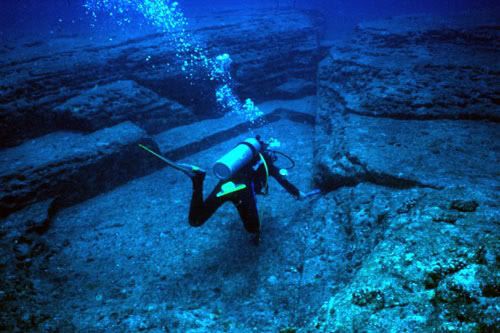
What's not in doubt is that the Yonaguni Monument is quite spectacular, consisting of a geometric terraced structure 27 metres high with vertical walls, as well as a number of other structures resembling trenches, paths, platforms and megaliths. These could well be geological formations similar to the geometric, smooth shapes of Giant's Causeway in Northern Ireland. If on the other hand the site was man-made (or at least man-enhanced), it could, controversially, suggest that people were living on Yonaguni 10,000 years ago.
9. Mahabalipuram (India)
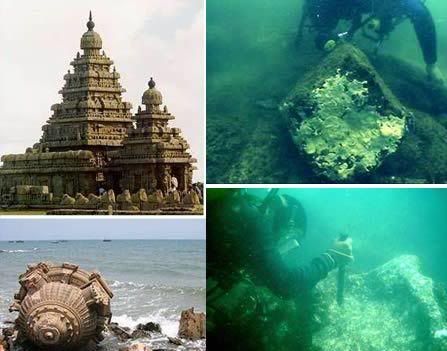
Mahabalipuram in India's Tamil Nadu province is a UNESCO World Heritage site even though part of the city is thought to be under water.
During the Indian Ocean tsunami of 2004 large sandbanks were washed away from Mahabalipuram's beach, uncovering walls, statues of lions, elephants, horses and deities, and temples from the Pallava period of the seventh to ninth centuries AD.
Eighteenth century travellers to the area wrote about seven temples that were on Mahabalipuram's shoreline. These structures could now be submerged and an archaeological investigation is being carried out by the Archaeological Survey of India.
At its height, Mahabalipuram was a city ruled by the Pallava dynasty, which rose to power during the sixth and seventh centuries. It was renowned for its architecture and carvings, which can still be seen in the city's surviving ancient temples.
8. Dolichiste and Simena (Turkey)
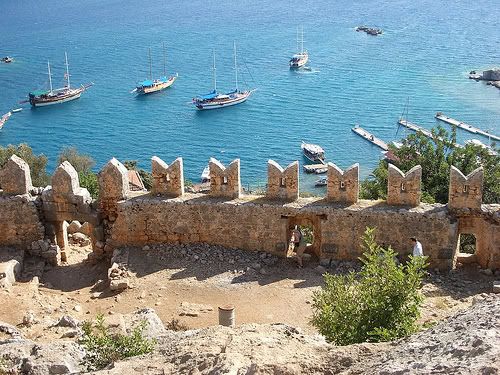
Kekova is an island about half a kilometre off the southern coast of Turkey, south-west of Antalya. It was the site of the ancient cities of Dolichiste and Simena, which were part of ancient Lycia – but little is left of the cities except for submerged ruins off the island's coast.
Lycia was a region of Anatolia and established a Lycian League of ancient cities in 168 BC, with its capital at Patara. The Romans under Claudius annexed Lycia to the empire in around 43 AD. The cities of Simena and Dolichiste are mentioned by Ptolemy and Pliny and date back to the fourth century BC.
They were destroyed by an earthquake in the second century AD, which submerged the land they were built on, plummeting them into the sea. At Simena, fountains, staircases and houses, as well as the ancient port, are all visible under water. Part of ancient Simena was also on the main land and this part has a small ancient amphitheatre, baths dedicated to the emperor Titus and the remains of numerous ancient sarcophagi.
7. Dunwich (United Kingdom)
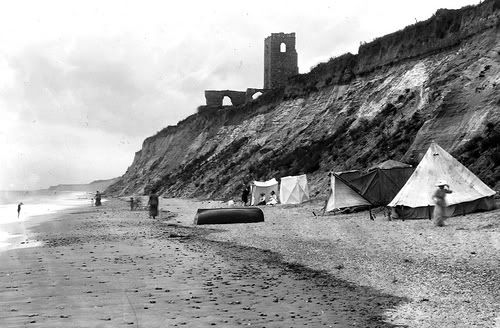
Until the the 15th century Dunwich, on the coast of East-Anglia in England, was a thriving city, a centre for Medieval trade that rivalled even London in terms of its prosperity at that time. But the city was cut off in its prime by coastal erosion and surging tides. Most of Dunwich is now no more than a ruin on the sea bed.
Four hundred houses were destroyed by the storms of 1328 and 1348, along with priories, churches and a windmill.
While archaeologists are unsure of the whereabouts of all these structures, a project is under way to map the coastal area with acoustic imaging technology.
6. Atlit-Yam (Israel)

It wasn't just cities from the classical Greek and Roman periods that were consumed by the Mediterranean - Neolithic settlements have also been found on the sea bed. Off the Carmel coast in Israel, about 15km south of Haifa, between 200-400m out to sea and at a depth of up to 12m, are the remains of a settlement that is about 8,000 years old. Atlit-Yam covers an area of about 40,000 square metres and includes seven stone megaliths at a ritual site (six of them still upright), stone water wells, stone walls, foundations for rectangular buildings, paved areas and burials sites. Sixty-five human skeletons have been found at the site (according to the Israel Antiquities Authority) - some of which showed signs of inner-ear disease caused by diving in cold water. Animal remains at the site include many types of fish bones, wild animals and some, such as cattle, which were semi-domesticated.
Atlit-Yam is the earliest known site on the Levantine coast that shows a society based on agriculture, domesticated animals and marine hunting. It would have been a complex economy, using diverse resources for survival. This would have come to an end somehow – who knows how or when – when sea levels rose and left Atlit-Yam many metres below the surface. Nearby are five other submerged Neolithic settlements from the Wadi Rabah culture.
5. Caesarea Maritima (Israel)
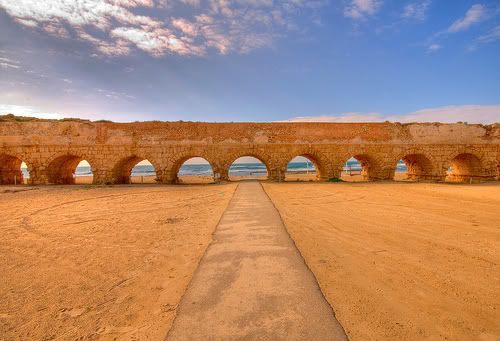
Caesarea Maritima (renamed Caesarea Palaestina in 133 AD) was a city and port built by Herod the Great during 25-13 BC. Herod used complex building techniques and hydraulic concrete to build a massive harbour for his city jutting out into the sea.
It was a bold construction that made an impressive entrance to the Roman city in the eastern Mediterranean – it was the largest artificial harbour built in the open sea at the time it was built during the first century.
But as with many superlative man-made structures (eg., the Titanic, the Channel Tunnel), Herod's moles soon ran into problems. They had been built so quickly that some of the concrete used inside them hadn't been properly mixed and this weakened the arms of the harbour. There was a tsunami during the first and second centuries AD and furthermore the harbour lay on a seismic fault line, which would have caused subsidence. The harbour had subsided and was abandoned by the sixth century AD.
In 2006 an underwater museum opened in Caesarea Maritima offering snorkelling and scuba diving tours of Herod's harbour.
4. Pavlopetri (Greece)
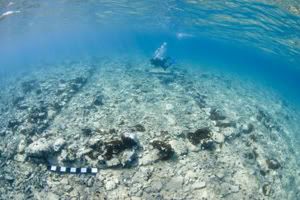
The Mycenaean town of Pavlopetri, off the southern coast of Greece near the modern town of Neapolis, is several metres under water.
Although the Mycenaean period dated from 1600-1100 BC, Pavlopetri dates back to the Neolithic period according to ceramics that have been found at the site, making it the oldest known submerged town. Pavlopetri was an important trading hub in the eastern Mediterranean until it became submerged abruptly around 1000 BC.
3. Dian Kingdom (China)
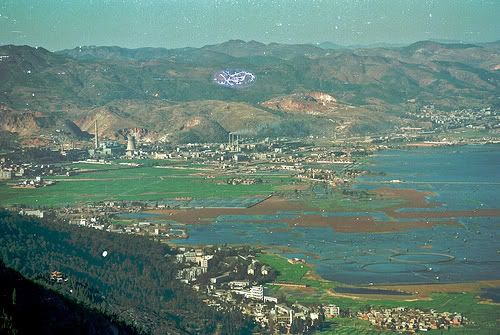
The Dian people lived in China's Yunnan province between the fifth century BC and the first century AD. They lived around Dian Lake (or Kunming Lake), at an altitude of almost 2km above sea level.
The Dian were accomplished artisans and produced bronze vessels and sculptures, which typically depicted scenes of hunting, dancing and other every-day activities and included wild animals such as tigers and oxen. Their territory included Lake Fuxian, partially in Yunnan province, where ancient ruins have been discovered beneath the surface.
It has been suggested these could be the remains of the capital city of the Dian people, which was destroyed by an earthquake and flood that killed all of the city's inhabitants in 110 AD.
2. Baiae and Portus Julius (Italy)
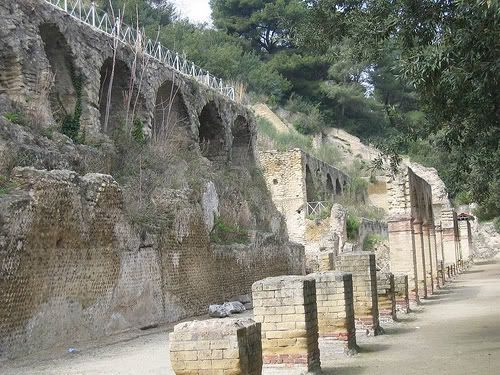
Baiae was one of the ancient Roman towns that overlooked the Bay of Naples. Once the seaside playground of rich Romans (an ancient St Tropez), many emperors spent time at their villas there.
Baiae was connected to one of the Roman empire's biggest naval bases, Portus Julius, built in 37-36 BC and home to the Classis Misenensis, Rome's formidable fleet.
Portus Julius and Baiae were built on a tract of volcanic land that was given to seismic movements, known as the Phlegraean Fields.
With time the volcanic activity meant that part of the land subsided, with the result that Roman villas, much of the structure of the port and other structures are now only visible to scuba divers or visitors on a glass-bottomed boat.
1. Heracleion and Cleopatra's Palace, Alexandria (Egypt)
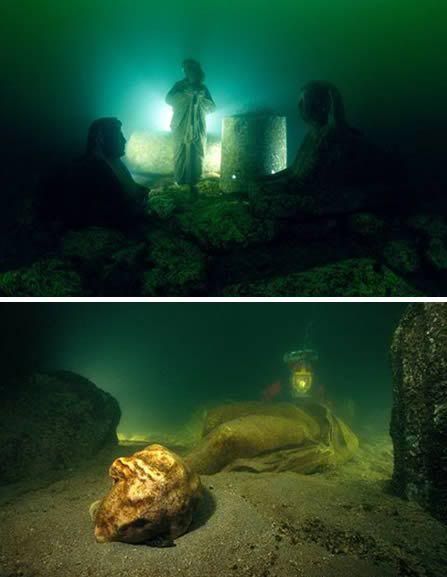
Perhaps the most grand and famous of all drowned cities, Heracleion was the port city of Alexandria, Egypt. It was the port of pharoahs and emperors dating back to the 12th century BC, while the living quarters of Cleopatra have been discovered nearby.
Heracleion was named after Hercules, who is believed to have visited the city along with Helen of Troy. But in the eighth century disaster struck and Heracleion was hit by earthquakes and floods, which destroyed the city, submerging it – along with Cleopatra's Palace – in the Mediterranean. In 2000 the site was re-discovered by a team of French underwater archaeologists, who have since found hieroglyphic tablets of stone, gold jewellery, amulets, coins and plates. The temple of Amun has been discovered as well as colossal statues dating from the late pharaonic period. A team led by French underwater archaeologist Franck Goddio has also found the site believed to be Cleopatra's palace, which was abandoned soon after her suicide in 31 BC.
No comments:
Post a Comment